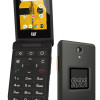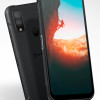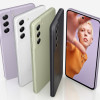Report from Redmond
Customization
As I touched on before, Pocket PCs and Smartphones are highly customizable. This is perfectly in line with the current trends in mobile phones. The use of GIF, JPEG and WAV files makes customizing a Smartphone extremely easy for anyone comfortable with Windows.
Microsoft even offers a free Pocket PC Theme Generator for Windows that gives you fine-grained control over your desktop image, and also lets you create a matching color scheme for the interface elements. It's fairly straightforward to use, although it's a bit buggy - it doesn't work at all if you have your display DPI set to 120 or some other high setting.
But beyond ringtones and wallpaper, and the ability to add new applications, there is also the Home Screen. Much like the "Today" screen on Pocket PCs, the Home screen summarizes key information in one place. But Smartphone takes the concept further by allowing customized XML-based Home screens, which can include device info (signal strength, etc.), carrier branding and color scheme, and even intelligent plug-ins containing logic and information culled from databases. Carriers can use this feature to provide a distinctive personality for the Smartphones they sell. Speaking of carriers...
The Role of Carriers
While both Pocket PC and Smartphone are powerful, feature-rich platforms, people who follow cell phone features closely might be surprised by some of the features that are not included. For example, Bluetooth, voice dialing, ringer ID, picture ID, and MMS are not part of either OS. The reason given by Microsoft is that these operating systems are merely foundations to build on, not turnkey solutions.
Therefore, it is up to the manufacturers to add features like voice dialing and Bluetooth, and it is up to carriers to add features like ringer ID, picture ID, and MMS. The idea is that carriers can basically create their own devices a-la-carte. The OS comes from Microsoft, the hardware comes from a contract manufacturer, and additional software to round out the feature set comes from in-house programmers or third-party developers.
This strategy has already become evident with the Pocket PC Phone Edition manufactured by HTC. AT&T's Siemens SX56 comes with a much more robust software suite than the T-Mobile version. One key feature added by AT&T is the ability for corporations to "push" configuration info and updates to employees' Pocket PCs automatically over-the-air (OTA).
But Smartphone gives carriers even more control. The OTA features mentioned above are built-in with Smartphone. At any time, carriers can connect to the device wirelessly and manage the registry, file system, and metabase. This is handy for things like configuring GPRS - it can be done totally automatically, without fiddling with tricky settings.
Another very cool feature is the ability to do OTA ROM updates. So when new versions of the Smartphone OS are released, carriers can actually push the update out to the phones automatically, instead of requiring customers to bring their phone into a retail store or service center to be updated.
But it goes further... Carriers can also choose to lock down the Smartphones that they sell, so that only "approved" (digitally signed) applications can be installed on the device. Even if carriers opt not to do this at first, they can force this change at any time via an OTA update. This introduces a whole new type of "locking" to limit consumers' ability to use their devices as they see fit.
So, if carriers leave their devices "unlocked" as far as applications, the platform is powerful enough that you could simply add applications yourself, a-la-carte, to basically create a phone with the exact features you want. (With SDIO cards, this even extends to hardware.) But if carriers lock their Smartphones, (which most probably will,) you're totally dependent on the carrier to include, or make available, applications that provide the features you want.


 Samsung Refreshes Galaxy S Series with S Pen, New Cameras
Samsung Refreshes Galaxy S Series with S Pen, New Cameras
 CAT Puts Android With Play Store in a Compact Flip Design
CAT Puts Android With Play Store in a Compact Flip Design
 Samsung Lets You Design Your Own Galaxy Z Flip3
Samsung Lets You Design Your Own Galaxy Z Flip3
 Kyocera Intros Slim, Rugged 5G Phone for Consumers
Kyocera Intros Slim, Rugged 5G Phone for Consumers
 Samsung Revives S21 Fan Edition
Samsung Revives S21 Fan Edition

